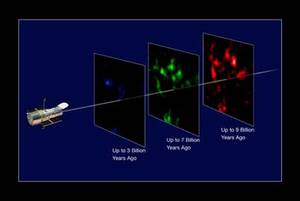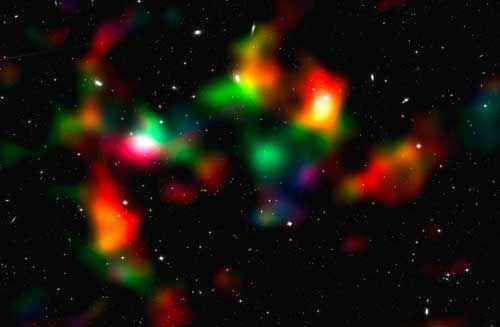01.04.2010
Cosmic Acceleration Confirmed with Weak Lensing
A new study led by European scientists presents the most comprehensive analysis of data from the most ambitious survey ever undertaken by the NASA/ESA Hubble Space Telescope. These researchers have, for the first time ever, used Hubble data to probe the effects of the natural gravitational “weak lenses” in space and characterise the expansion of the Universe. Dr. Martin Kilbinger of the Junior Resarch Group “Observational Astrophysics” at the Excellence Cluster Universe is one of the co-authors of the study to be published in an upcoming issue of Astronomy and Astrophysics.
A group of astronomers led by Tim Schrabback of the Leiden Observatory, conducted an intensive study of over 446.000 galaxies within the COSMOS field, the result of the largest survey ever conducted with Hubble. In making the COSMOS survey, Hubble photographed 575 slightly overlapping views of the same part of the Universe using the Advanced Camera for Surveys (ACS) onboard Hubble. It took nearly 1000 hours of observations.
In this illustration the NASA/ESA Hubble Space Telescope looks back in time to "map" evolving dark matter. The dataset is created by splitting the background source galaxy population into discrete epochs of time (like cutting through geological strata), looking back into the past. This is calibrated by measuring the cosmological redshift of the lensing galaxies used to map the dark matter distribution, and putting them into different time/distance "slices". // Image Credits: NASA, ESA, P. Simon (University of Bonn) and T. Schrabback (Leiden Observatory)
In addition to the Hubble data, researchers used redshift [1] data from ground-based telescopes to assign distances to 194 000 of the galaxies surveyed (out to a redshift of 5).
In particular, the astronomers could “weigh” the large-scale matter distribution in space over large distances. To do this, they made use of the fact that this information is encoded in the distorted shapes of distant galaxies, a phenomenon referred to as weak gravitational lensing [2]. Using complex algorithms, the team led by Schrabback has improved the standard method and obtained galaxy shape measurements to an unprecedented precision.
The meticulousness and scale of this study enables an independent confirmation that the expansion of the Universe is accelerated by an additional, mysterious component named dark energy. A handful of other such independent confirmations exist. Scientists need to know how the formation of clumps of matter evolved in the history of the Universe to determine how the gravitational force, which holds matter together, and dark energy, which pulls it apart by accelerating the expansion of the Universe, have affected them. “Dark energy affects our measurements for two reasons. First, when it is present, galaxy clusters grow more slowly, and secondly, it changes the way the Universe expands, leading to more distant — and more efficiently lensed — galaxies. Our analysis is sensitive to both effects,” says co-author Benjamin Joachimi from the University of Bonn. “Our study also provides an additional confirmation for Einstein’s theory of general relativity, which predicts how the lensing signal depends on redshift,” adds co-investigator Martin Kilbinger from the Institut d'Astrophysique de Paris and the Excellence Cluster Universe.
[1] In astronomy, the redshift denotes the fraction by which the lines in the spectrum of an object are shifted towards longer wavelengths due to the expansion of the Universe. The observed redshift of a remote galaxy provides an estimate of its distance.
[2] Weak gravitational lensing: The phenomenon of gravitational lensing is the warping of spacetime by the gravitational field of a concentration of matter, such as a galaxy cluster. When light rays from distant background galaxies pass this matter concentration, their path is bent and the galaxy images are distorted. In the case of weak lensing, these distortions are small, and must be measured statistically. This analysis provides a direct estimate for the strength of the gravitational field, and therefore the mass of the matter concentration. When determining precise shapes of galaxies, astronomers have to deal with three main factors: the intrinsic shape of the galaxy (which is unknown), the gravitational lensing effect they want to measure, and systematic effects caused by the telescope and camera, as well as the atmosphere, in case of ground-based observations.
Links:
- Image of the COSMOS field: http://www.spacetelescope.org/images/html/heic0701g.html
- Science paper: http://www.spacetelescope.org/static/archives/releases/science_papers/heic1005_sciencepaper.pdf
Image Credits: NASA, ESA, P. Simon (University of Bonn) and T. Schrabback (Leiden Observatory)







